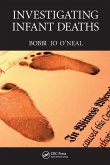Cyril H Wecht, Henry C Lee, D P van Blaricom, Mel Tucker
Investigation and Prevention of Officer-Involved Deaths
Cyril H Wecht, Henry C Lee, D P van Blaricom, Mel Tucker
Investigation and Prevention of Officer-Involved Deaths
- Broschiertes Buch
- Merkliste
- Auf die Merkliste
- Bewerten Bewerten
- Teilen
- Produkt teilen
- Produkterinnerung
- Produkterinnerung
An in-depth examination of all the facets of investigating police-related deaths, this book includes coverage of death scene investigation for reconstruction. It discusses collection of physical evidence, interviews, medical examination of the decedent, psychological factors involving both parties, and litigation of alleged police misconduct. Th
Andere Kunden interessierten sich auch für
![Investigating Infant Deaths Investigating Infant Deaths]() Bobbi Jo O'NealInvestigating Infant Deaths81,99 €
Bobbi Jo O'NealInvestigating Infant Deaths81,99 €![Forensic Toxicology Forensic Toxicology]() Kalipatnapu N RaoForensic Toxicology110,99 €
Kalipatnapu N RaoForensic Toxicology110,99 €![Effective Expert Witnessing, Fourth Edition Effective Expert Witnessing, Fourth Edition]() Jack V MatsonEffective Expert Witnessing, Fourth Edition79,99 €
Jack V MatsonEffective Expert Witnessing, Fourth Edition79,99 €![A Primer on Clinical Experience in Medicine A Primer on Clinical Experience in Medicine]() Md JenicekA Primer on Clinical Experience in Medicine52,99 €
Md JenicekA Primer on Clinical Experience in Medicine52,99 €![Three Shots at Prevention Three Shots at Prevention]() Three Shots at Prevention39,99 €
Three Shots at Prevention39,99 €![Fed Up with the Right to Food? Fed Up with the Right to Food?]() Fed Up with the Right to Food?100,99 €
Fed Up with the Right to Food?100,99 €![Governing Food Security Governing Food Security]() Governing Food Security136,99 €
Governing Food Security136,99 €-
-
-
An in-depth examination of all the facets of investigating police-related deaths, this book includes coverage of death scene investigation for reconstruction. It discusses collection of physical evidence, interviews, medical examination of the decedent, psychological factors involving both parties, and litigation of alleged police misconduct. Th
Hinweis: Dieser Artikel kann nur an eine deutsche Lieferadresse ausgeliefert werden.
Hinweis: Dieser Artikel kann nur an eine deutsche Lieferadresse ausgeliefert werden.
Produktdetails
- Produktdetails
- Verlag: Taylor & Francis
- Seitenzahl: 230
- Erscheinungstermin: 14. Oktober 2024
- Englisch
- Abmessung: 234mm x 156mm
- Gewicht: 453g
- ISBN-13: 9781032926469
- ISBN-10: 1032926465
- Artikelnr.: 71646037
- Herstellerkennzeichnung
- Libri GmbH
- Europaallee 1
- 36244 Bad Hersfeld
- gpsr@libri.de
- Verlag: Taylor & Francis
- Seitenzahl: 230
- Erscheinungstermin: 14. Oktober 2024
- Englisch
- Abmessung: 234mm x 156mm
- Gewicht: 453g
- ISBN-13: 9781032926469
- ISBN-10: 1032926465
- Artikelnr.: 71646037
- Herstellerkennzeichnung
- Libri GmbH
- Europaallee 1
- 36244 Bad Hersfeld
- gpsr@libri.de
Cyril H Wecht, M.D. Cyril H. Wecht Institute of Forensic Science & Law, Pittsburgh, Pennsylvania, USA. Dr Henry C Lee, DP Van Blaricom Chief of Police (Retired), Bellevue, Washington, USA. Mel Tucker Raleigh North Carolina, USA.
Reducing and Preventing Deaths by Training and Policy Guidance High-Risk
Business Civil Liability Negligence Civil Rights Law Enforcement Training
Contemporary Law Enforcement Training Basic Recruit and In-Service Training
Programs The Field Training Officer Program Job Task Analysis and Training
The Need for Change and Leadership Training to Prevent Mistakes and
Liability Focused Training on Authority to Use Force Focused Training on
Preemptive Action Policies Can Reduce Deaths Supreme Court Decisions on the
Use of Force Policy Guidance and Domestic Violence The Exercise of
Discretion Prevention of Illegitimate Exercise of Discretion National
Advisory Commission on Criminal Justice Standards and Goals Variables
Policies and Procedures The National Law Enforcement Policy Center Police
Policies and Official Immunity Identification of Areas in Which Policy and
Procedure Guidance Is Needed Summary Endnotes Less-Lethal Weapons Reducing
Injury and Death Types of Incidents Less-Lethal Not Required by Law The
Ideal Less-Lethal Weapon The National Law Enforcement Technology Center
Capture Devices Impact Weapons (Beanbags) Conducted Energy Devices (CEDs)
Operational Success of CEDs Scenario How Would You Have Handled the above
Scenario? Summary Endnotes Officer-Involved Shootings (OISs) What Would You
Have Done? Best Practices Crime Scene Investigation Preliminary
Reconstruction Releasing the Scene Laboratory Analysis and Reconstruction
Cartridge Cases / Shells Weapon Examination Gunshot Residues (GSR)
Examination of Ricochet Bullets Bloodstain Pattern and Tissue Examination
Reconstruction Pathology / Medical Examination Endnotes Appendix: IACP
National Law Enforcement Policy Center Concepts and Issues Paper Titled
Investigation of Officer-Involved Shootings (August 1999) Notes Emergency
Vehicle Operations What Would You Have Done? Investigation of Accidents
Crime Scene Investigation Best Practices Pathology Autopsy Report of Police
Shooting during Pursuit Endnotes Appendix: IACP Vehicular Pursuit Policy
Excited Delirium What Would You Have Done? Best Practices Based upon What
We Know Investigation of the Scene General Crime Scene Procedure
Collection, Preservation, and Packaging of Physical Evidence Preliminary
Reconstruction Releasing the Scene TASER and Excited Delirium Endnotes
Suicide-by-Cop (SbC) Incidents Indicators of Suicide-by-Cop A Typical SbC
Scenario What Would You Have Done? SbC Resolution Tactics Investigation at
the SbC Scene General SbC Scene Procedures Crime Scene Search Assignment of
Responsibility Preliminary Reconstruction Releasing the Scene Summary of
Crime Scene Procedures The Future Endnotes Positional Asphyxiation What
Would You Have Done? Best Practices Crime Scene and Forensic Evidence
General Procedures Documentation of the Crime Scene Preliminary
Reconstruction Autopsy Report -Positional Asphyxia Death Sample Report of
Opinions of a Coroner's Office Summary Endnotes In-Custody Deaths What
Would You Have Done? Example-Pathological Examination Gross Description
Medical Treatment of Prisoners Best Practices Endnotes Emotionally
Disturbed Persons What Would You Have Done? Best Practices Crises
Intervention Teams Crime Scene and Forensic Evidence General Scene
Procedure Crime Scene Investigation Preliminary Reconstruction Releasing
the Scene Laboratory Analysis Cartridge Cases/Shells Weapon Examination
Gunshot Residues Examination of Ricochet Bullets Bloodstain Pattern and
Tissues Examination Reconstruction Endnotes Index
Business Civil Liability Negligence Civil Rights Law Enforcement Training
Contemporary Law Enforcement Training Basic Recruit and In-Service Training
Programs The Field Training Officer Program Job Task Analysis and Training
The Need for Change and Leadership Training to Prevent Mistakes and
Liability Focused Training on Authority to Use Force Focused Training on
Preemptive Action Policies Can Reduce Deaths Supreme Court Decisions on the
Use of Force Policy Guidance and Domestic Violence The Exercise of
Discretion Prevention of Illegitimate Exercise of Discretion National
Advisory Commission on Criminal Justice Standards and Goals Variables
Policies and Procedures The National Law Enforcement Policy Center Police
Policies and Official Immunity Identification of Areas in Which Policy and
Procedure Guidance Is Needed Summary Endnotes Less-Lethal Weapons Reducing
Injury and Death Types of Incidents Less-Lethal Not Required by Law The
Ideal Less-Lethal Weapon The National Law Enforcement Technology Center
Capture Devices Impact Weapons (Beanbags) Conducted Energy Devices (CEDs)
Operational Success of CEDs Scenario How Would You Have Handled the above
Scenario? Summary Endnotes Officer-Involved Shootings (OISs) What Would You
Have Done? Best Practices Crime Scene Investigation Preliminary
Reconstruction Releasing the Scene Laboratory Analysis and Reconstruction
Cartridge Cases / Shells Weapon Examination Gunshot Residues (GSR)
Examination of Ricochet Bullets Bloodstain Pattern and Tissue Examination
Reconstruction Pathology / Medical Examination Endnotes Appendix: IACP
National Law Enforcement Policy Center Concepts and Issues Paper Titled
Investigation of Officer-Involved Shootings (August 1999) Notes Emergency
Vehicle Operations What Would You Have Done? Investigation of Accidents
Crime Scene Investigation Best Practices Pathology Autopsy Report of Police
Shooting during Pursuit Endnotes Appendix: IACP Vehicular Pursuit Policy
Excited Delirium What Would You Have Done? Best Practices Based upon What
We Know Investigation of the Scene General Crime Scene Procedure
Collection, Preservation, and Packaging of Physical Evidence Preliminary
Reconstruction Releasing the Scene TASER and Excited Delirium Endnotes
Suicide-by-Cop (SbC) Incidents Indicators of Suicide-by-Cop A Typical SbC
Scenario What Would You Have Done? SbC Resolution Tactics Investigation at
the SbC Scene General SbC Scene Procedures Crime Scene Search Assignment of
Responsibility Preliminary Reconstruction Releasing the Scene Summary of
Crime Scene Procedures The Future Endnotes Positional Asphyxiation What
Would You Have Done? Best Practices Crime Scene and Forensic Evidence
General Procedures Documentation of the Crime Scene Preliminary
Reconstruction Autopsy Report -Positional Asphyxia Death Sample Report of
Opinions of a Coroner's Office Summary Endnotes In-Custody Deaths What
Would You Have Done? Example-Pathological Examination Gross Description
Medical Treatment of Prisoners Best Practices Endnotes Emotionally
Disturbed Persons What Would You Have Done? Best Practices Crises
Intervention Teams Crime Scene and Forensic Evidence General Scene
Procedure Crime Scene Investigation Preliminary Reconstruction Releasing
the Scene Laboratory Analysis Cartridge Cases/Shells Weapon Examination
Gunshot Residues Examination of Ricochet Bullets Bloodstain Pattern and
Tissues Examination Reconstruction Endnotes Index
Reducing and Preventing Deaths by Training and Policy Guidance High-Risk
Business Civil Liability Negligence Civil Rights Law Enforcement Training
Contemporary Law Enforcement Training Basic Recruit and In-Service Training
Programs The Field Training Officer Program Job Task Analysis and Training
The Need for Change and Leadership Training to Prevent Mistakes and
Liability Focused Training on Authority to Use Force Focused Training on
Preemptive Action Policies Can Reduce Deaths Supreme Court Decisions on the
Use of Force Policy Guidance and Domestic Violence The Exercise of
Discretion Prevention of Illegitimate Exercise of Discretion National
Advisory Commission on Criminal Justice Standards and Goals Variables
Policies and Procedures The National Law Enforcement Policy Center Police
Policies and Official Immunity Identification of Areas in Which Policy and
Procedure Guidance Is Needed Summary Endnotes Less-Lethal Weapons Reducing
Injury and Death Types of Incidents Less-Lethal Not Required by Law The
Ideal Less-Lethal Weapon The National Law Enforcement Technology Center
Capture Devices Impact Weapons (Beanbags) Conducted Energy Devices (CEDs)
Operational Success of CEDs Scenario How Would You Have Handled the above
Scenario? Summary Endnotes Officer-Involved Shootings (OISs) What Would You
Have Done? Best Practices Crime Scene Investigation Preliminary
Reconstruction Releasing the Scene Laboratory Analysis and Reconstruction
Cartridge Cases / Shells Weapon Examination Gunshot Residues (GSR)
Examination of Ricochet Bullets Bloodstain Pattern and Tissue Examination
Reconstruction Pathology / Medical Examination Endnotes Appendix: IACP
National Law Enforcement Policy Center Concepts and Issues Paper Titled
Investigation of Officer-Involved Shootings (August 1999) Notes Emergency
Vehicle Operations What Would You Have Done? Investigation of Accidents
Crime Scene Investigation Best Practices Pathology Autopsy Report of Police
Shooting during Pursuit Endnotes Appendix: IACP Vehicular Pursuit Policy
Excited Delirium What Would You Have Done? Best Practices Based upon What
We Know Investigation of the Scene General Crime Scene Procedure
Collection, Preservation, and Packaging of Physical Evidence Preliminary
Reconstruction Releasing the Scene TASER and Excited Delirium Endnotes
Suicide-by-Cop (SbC) Incidents Indicators of Suicide-by-Cop A Typical SbC
Scenario What Would You Have Done? SbC Resolution Tactics Investigation at
the SbC Scene General SbC Scene Procedures Crime Scene Search Assignment of
Responsibility Preliminary Reconstruction Releasing the Scene Summary of
Crime Scene Procedures The Future Endnotes Positional Asphyxiation What
Would You Have Done? Best Practices Crime Scene and Forensic Evidence
General Procedures Documentation of the Crime Scene Preliminary
Reconstruction Autopsy Report -Positional Asphyxia Death Sample Report of
Opinions of a Coroner's Office Summary Endnotes In-Custody Deaths What
Would You Have Done? Example-Pathological Examination Gross Description
Medical Treatment of Prisoners Best Practices Endnotes Emotionally
Disturbed Persons What Would You Have Done? Best Practices Crises
Intervention Teams Crime Scene and Forensic Evidence General Scene
Procedure Crime Scene Investigation Preliminary Reconstruction Releasing
the Scene Laboratory Analysis Cartridge Cases/Shells Weapon Examination
Gunshot Residues Examination of Ricochet Bullets Bloodstain Pattern and
Tissues Examination Reconstruction Endnotes Index
Business Civil Liability Negligence Civil Rights Law Enforcement Training
Contemporary Law Enforcement Training Basic Recruit and In-Service Training
Programs The Field Training Officer Program Job Task Analysis and Training
The Need for Change and Leadership Training to Prevent Mistakes and
Liability Focused Training on Authority to Use Force Focused Training on
Preemptive Action Policies Can Reduce Deaths Supreme Court Decisions on the
Use of Force Policy Guidance and Domestic Violence The Exercise of
Discretion Prevention of Illegitimate Exercise of Discretion National
Advisory Commission on Criminal Justice Standards and Goals Variables
Policies and Procedures The National Law Enforcement Policy Center Police
Policies and Official Immunity Identification of Areas in Which Policy and
Procedure Guidance Is Needed Summary Endnotes Less-Lethal Weapons Reducing
Injury and Death Types of Incidents Less-Lethal Not Required by Law The
Ideal Less-Lethal Weapon The National Law Enforcement Technology Center
Capture Devices Impact Weapons (Beanbags) Conducted Energy Devices (CEDs)
Operational Success of CEDs Scenario How Would You Have Handled the above
Scenario? Summary Endnotes Officer-Involved Shootings (OISs) What Would You
Have Done? Best Practices Crime Scene Investigation Preliminary
Reconstruction Releasing the Scene Laboratory Analysis and Reconstruction
Cartridge Cases / Shells Weapon Examination Gunshot Residues (GSR)
Examination of Ricochet Bullets Bloodstain Pattern and Tissue Examination
Reconstruction Pathology / Medical Examination Endnotes Appendix: IACP
National Law Enforcement Policy Center Concepts and Issues Paper Titled
Investigation of Officer-Involved Shootings (August 1999) Notes Emergency
Vehicle Operations What Would You Have Done? Investigation of Accidents
Crime Scene Investigation Best Practices Pathology Autopsy Report of Police
Shooting during Pursuit Endnotes Appendix: IACP Vehicular Pursuit Policy
Excited Delirium What Would You Have Done? Best Practices Based upon What
We Know Investigation of the Scene General Crime Scene Procedure
Collection, Preservation, and Packaging of Physical Evidence Preliminary
Reconstruction Releasing the Scene TASER and Excited Delirium Endnotes
Suicide-by-Cop (SbC) Incidents Indicators of Suicide-by-Cop A Typical SbC
Scenario What Would You Have Done? SbC Resolution Tactics Investigation at
the SbC Scene General SbC Scene Procedures Crime Scene Search Assignment of
Responsibility Preliminary Reconstruction Releasing the Scene Summary of
Crime Scene Procedures The Future Endnotes Positional Asphyxiation What
Would You Have Done? Best Practices Crime Scene and Forensic Evidence
General Procedures Documentation of the Crime Scene Preliminary
Reconstruction Autopsy Report -Positional Asphyxia Death Sample Report of
Opinions of a Coroner's Office Summary Endnotes In-Custody Deaths What
Would You Have Done? Example-Pathological Examination Gross Description
Medical Treatment of Prisoners Best Practices Endnotes Emotionally
Disturbed Persons What Would You Have Done? Best Practices Crises
Intervention Teams Crime Scene and Forensic Evidence General Scene
Procedure Crime Scene Investigation Preliminary Reconstruction Releasing
the Scene Laboratory Analysis Cartridge Cases/Shells Weapon Examination
Gunshot Residues Examination of Ricochet Bullets Bloodstain Pattern and
Tissues Examination Reconstruction Endnotes Index








